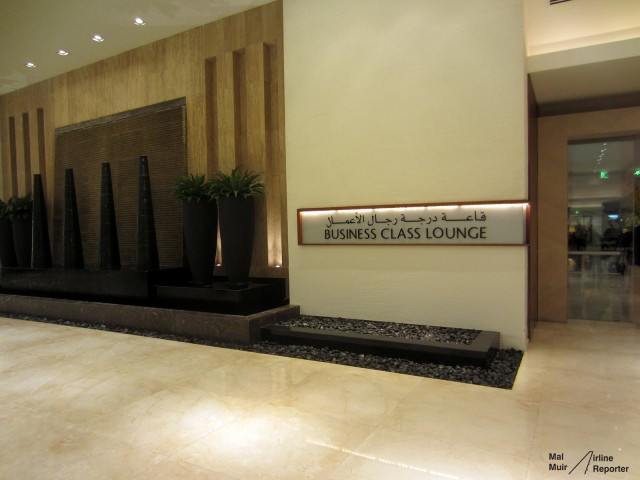
Business Class Lounge Entrance in the Qatar Airways Premium Terminal – Photo: Mal Muir / AirlineReporter.com
You’re flying business class to a faraway land. You’re scheduled for a five hour connection between your flights and this fills you with dread. It is not quite long enough to leave the airport to explore and all you can think of is being trapped. If you have a Business or First class ticket, flying Qatar Airways out of Doha, you have nothing to worry about.
Qatar Airways has something that no one else has at the Doha International Airport (DOH): their Premium Terminal. When you fly to/from/through Doha in either First or Business Class you have access to not just a lounge, but a whole VIP terminal.
There are other airlines that have private terminals for their First Class guests (Lufthansa in Frankfurt for example) but Qatar is special; they offer this amenity to Business Class guests as well.
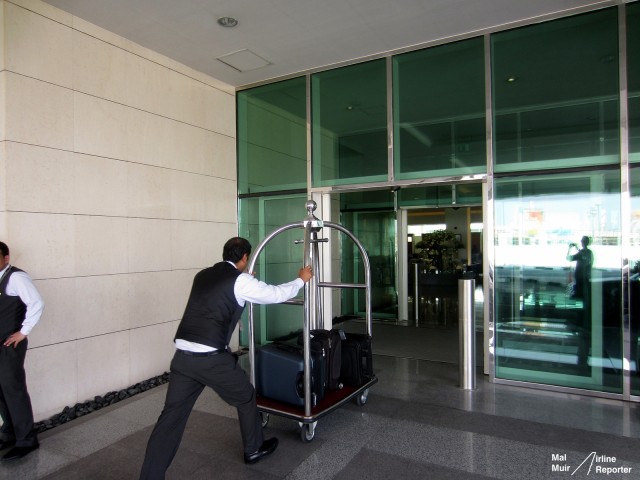
No Need to Carry your own bag, porters do it for you. Photo: Mal Muir / AirlineReporter.com
If you are departing from Doha, you do not need to go to the main terminal first. As you enter the airport facility, you head off to the right and start your travel directly at the Premium Terminal.
From the very moment you arrive, the service begins. You would normally need to drag your bags to check in and then worry about where to go, navigating your way through the large facilities, finding the right counters. Not so here.
A porter will open the door for you, help you with your bags, even guide you up to a counter where you can sit down at a desk and the check in staff will get your boarding pass for you, without a hassle in the world.
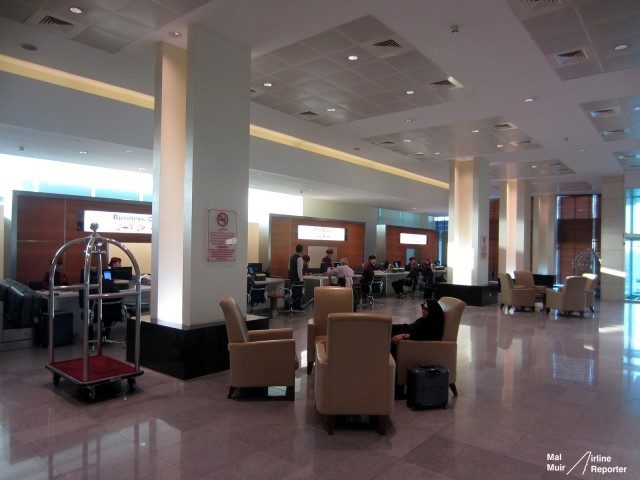
Private Check In Desks in the Qatar Airways Premium Terminal – Photo: Mal Muir / Airlinereporter.com
The staff will guide you towards the private immigration and security channels. You still have to go through the same process as everyone else in the airport, but it’s a little less crowded. I ended up going through during the morning rush hours and had to wait a few minutes’¦ the shock and horror! Even though the service before security is nice, the real treat starts after security.
On the main level is the Duty Free shop and the gates for the flights. The lounge is located up on the second floor where additional staff is there to greet you. Once complete, those with Business Class seats head left and those with First Class take a right — but not so fast.
The second floor is host to the ’œlounge area’ though it is not just a lounge — There are a number of facilities. You have a cloak room, a games room and nursery for the kids, a smoking lounge (several of them dotted throughout the terminal) and even a clinic in case you’re not feeling well. ATMs, phones and a lovely calming water feature are here as well.
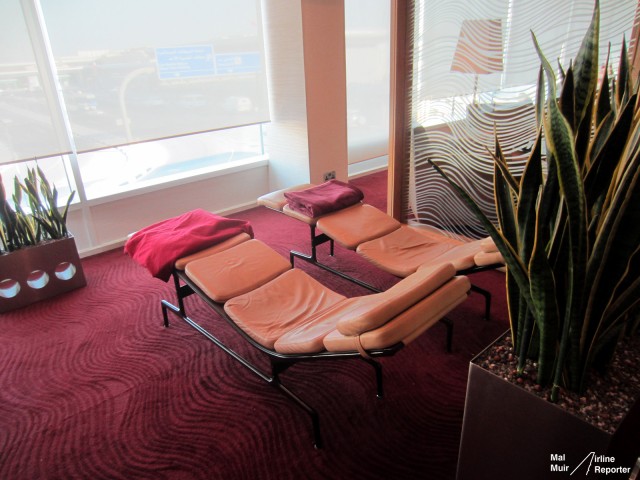
Tired? Why not take a quick nap in the Qatar Airways Premium Terminal? – Photo: Mal Muir / AirlineReporter.com
Once you enter the lounge, the real relaxation can begin. Located around the lounge are all different areas of comfort depending on what you wish to do with your time.
If getting down to business is your thing, there are private little cubicles which are more stylish than your usual office. If you feel like a little snack and a relaxing seat while maybe enjoying an espresso… do not worry… the lounge has it covered.
If eating on a lounge chair is not your thing, there are also sit down tables. Just be weary that a big snack can make you feel tired. There are comfy reclined seats, blanket and pillows to get you rested before your long flight.

Hungry? One of many food bars in the Qatar Airways Premium Terminal – Photo: Mal Muir / AirlineReporter.com
The food isn’t your typical lounge fare of cheese cubes and snack mix. At breakfast you can have a hot breakfast of poached eggs on toast or even waffles with berries and whipped cream. If you want something a bit lighter there are cereal and pastry choices as well.
Of course, if you feel like a cocktail and maybe a decadent little dessert before your flight, it is there for you as well. Whatever your mood or taste, I am sure you will be pleased.
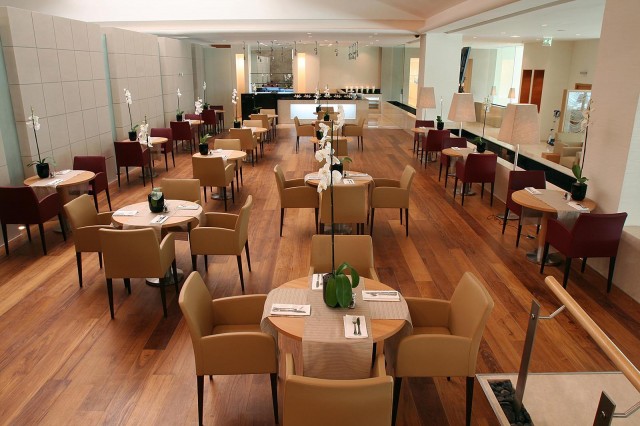
One of the two Dining Areas in the Qatar Airways Premium Terminal – Photo: Qatar Airways
You probably don’t want to board your plane smelling ripe, so using one of the showers might be a great idea.
If you have a First Class ticket, you also get access to a full spa. What could be more relaxing than taking a soothing soak in a spa bath/Jacuzzi right before your flight?
Soon enough your time in the lounge will come to an end and you will need to board your flight. No need to keep checking your flight status, when it is time to board, a staff member will come around quietly announcing your departure.
Back at the bottom of the escalators is the ’œGate Area.’ There are no rows of chairs here, no crowded area filled with pushing and fighting passengers. Instead there are only a row of counters and screens where employees will check your boarding pass and direct you to the buses waiting to take you to your plane.
This isn’t your typical bus either. When you are ready, a porter helps you onboard the and will help you with your bags (because surely you bought a lot at the duty free store right?).
Once all the seats are filled the door is shut, and your airport drive begins as you are bused directly to the boarding stairs for your aircraft. While economy board at the rear, me and the other business class passengers strolled up the forward steps.
It was now time to transition from an amazing ground-based experience to an airborne one on my Boeing 777-200LR flight back to the states (more on that soon).
Disclaimer: Qatar Airways paid for the trip to Qatar, all opinions are my own.
 |
This story written by…Malcolm Muir, Lead Correspondent. Mal is an Australian Avgeek now living and working in Seattle. With a passion for aircraft photography, traveling and the fun that combining the two can bring. Insights into the aviation world with a bit of a perspective thanks to working in the travel industry.
@BigMalX | BigMal’s World | Photos |

Boeing 787s on the flight line at Paine Field. Photo by Malcolm Muir.
I am an AvGeek that happens to write for AirlineReporter.com. Now, being a correspondent, I have access to connect with airline and Boeing PR people to get confirmations on things like deliveries, but recently, I tried some old fashion AvGeek-ness to try to find out how many 787s did Boeing really delivered recently.
On Thursday the 20th December I noticed a tweet pop up from @boeingairplanes that sparked my interest:

I had seen the flight line at Everett a bit over the last few weekends and there was a number of 787s all lined up ready to go and I knew that they had been doing plenty of test flights lately to push those 787s out before the end of year break. I decided to dig a bit deeper.
Consulting several sources including Flightaware for both Paine Field & Charleston AFB, where the two 787 factories are located, it was evident that this was entirely possible.
At that first stage only be four deliveries: three from Everett and one from Charleston. Where were those missing two? I was able to track the following deliveries:
I was starting to think that the other missing two must have been just financial deliveries. Then, on Friday the 21st another Tweet appeared:

Hmm, I felt it was time to get some official confirmation from Boeing. Scott Lefeber from the Boeing 787 Communications team confirmed via email that a total of 47 787’s had been delivered to date, and that a 787 delivery record had most definitely been broken; The record for the most amount of 787 aircraft ever delivered in one day.
At the time of publishing (I will update the story when I find out), Lefeber is unable to get confirm exactly how many were delivered. In question is a second787 for Qatar that had popped up on Flightaware while we were emailing.
By days end it was evident that a total of seven 787s were being delivered in the span of 36 hours. With the four deliveries listed above there was also:
It was great to see a fantastic accomplishment by the Boeing team with managing to get so many aircraft delivered in such a short time frame. Seven aircraft to six of the eight current operators is a good record. With all the bad press that has come about in the 787 program as of late, it is good to see something positive for once. Just in time for the new year.
 |
This story written by…Malcolm Muir, Lead Correspondent. Mal is an Australian Avgeek now living and working in Seattle. With a passion for aircraft photography, traveling and the fun that combining the two can bring. Insights into the aviation world with a bit of a perspective thanks to working in the travel industry.@BigMalX | BigMal’s World | Photos |
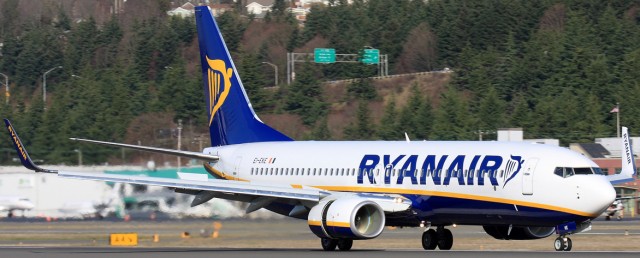
Ryanair Boeing 737 seen in Seattle before delivery. Photo by Jeremy Dwyer-Lindgren.
If you cover the airline world, you probably know the name, Stephen McNamara. He is the crazy (or pure genius) PR person behind Ryanair. I was shocked to recently read that he will be leaving Ryanair and heading over to Rugby Football Union as their Director of Communications.
You see, I have a special place in my heart for Mr. McNamara. He is well known as being elusive to many in the aviation journalism biz and I was extremely privileged to have him email me about some “mis-information” a while back. Him leaving has stirred up the memories and I wanted to reminisce.
It all started with me writing a story way back on March 10th 2010 about Ryanair stranding some passengers. The story showed up on my blog, but also on my Seattle PI syndication. This is where Mr. McNamara found my story and strongly disagreed with what he read. He wrote directly to the Seattle PI, but since they have no editorial control over my content, the email was forwarded to me. Mr. McNamara did not like that the Seattle PI was not able to change my story.
“Your answer is less than satisfactory and it is a damming indictment of the Seattlepi.com that you would allow clearly incorrect and biased information appear and remain on your site ’“ brushing this off as an issue for the publisher is simply rubbish ’“ it is on your site, you are the publisher,” McNamara stated in his response to the PI (see his full reply here). Even at this early stage in my blogging career, I knew I was on to some gold-standard material.
BONUS: The five stages passengers go through when flying ultra low-cost carriers — like Ryanair
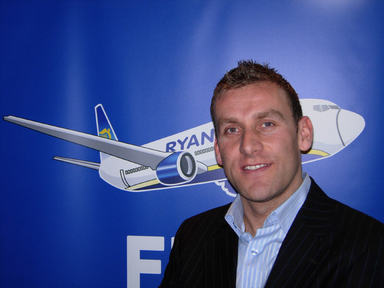
Stephen McNamara, currently head of PR for Ryanair.
I decided to write him back. I truly don’t want to be writing wrong information and was happy to update my story. Although he stated that he doesn’t “have the time (or resources) to correct the errors most bloggers come up with,” McNamara gave me a very long winded reply email correcting my mistakes. His reply was filled with even better material and I questioned if I should share his entire email or just give a summary. Knowing Ryanair loves the negative attention and the fact that the message was just too good not to share, I made the decision to copy and paste.
If the same thing would happen today, I probably wouldn’t make the same move, but there are benefits to being a lesser known blogger.
Don’t get me wrong here… I have tremendous respect for Ryanair and Mr. McNamara. The crazy ideas they have come up with, just to get free publicity, have been pure genius. The fact that so many journalists around the world pick up the stories as fact has been hilarious.
Passengers and media love to hate this airline, but their business model of extreme ala-cart pricing and laughable headlines getting them free publicity has made them one of the most successful airlines.
It is amusing to me that some headings (example one and two) stated that working as head of Ryanair PR is the worst PR job in the world (well, Ryanair CEO Michael O’Leary actually said it first). I think I have to disagree a bit. Where else can you come up with stories, like offering standing seats only, banning kids from flights, requiring passengers to pay for toilets or state you are looking at only having one pilot instead of two in each plane and have media around the world eat up your story and give your company publicity? That sounds like a pretty rad PR job to me.
So, Mr. McNamara, I salute you and the work you have done at Ryanair. I hope your replacement is as equally entertaining and able to provide high-end content for little ‘ol bloggers like me. The fact that I have traveled the world to cover different airline and travel stories, but our interaction over two and a half years ago is still one of my favorite all-time stories says something. I wish you the best of luck.
NOTE: I will be emailing Mr. McNamara with a link to this story hoping to get some sort of comment. If so, I will update the story. I wouldn’t hold your breath, but it is the giving season right?
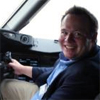 |
This story written by… David Parker Brown, Editor & Founder.
David started AirlineReporter.com in the summer of 2008, but has had a passion for aviation since he was a kid. Born and raised in the Seattle area (where he is currently based) has surely had an influence and he couldn’t imagine living anywhere else in the world.
@AirlineReporter | Flickr | YouTube |
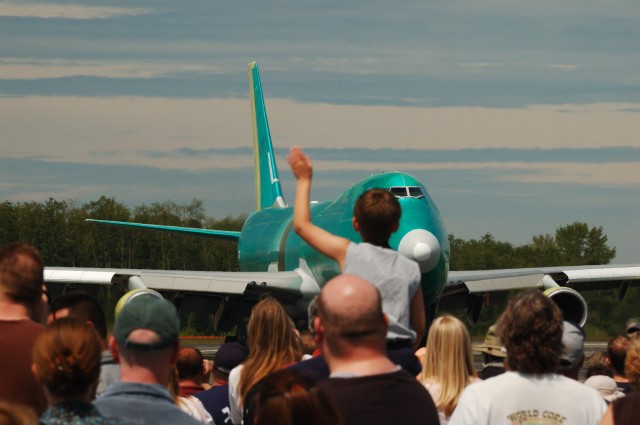
A Boeing 747-400F taxi’s during Paine Field Aviation Day 2009. Photo by Les Smith.
Sometimes a photo (or two) come along that I feel defines why I do this blog and love aviation. These are two of those photos and I wanted to share. These show one of the last 744F’s taxiing and taking off at Paine Field. But the photos are not about the aircraft, but for me, it is about the people (and especially that child waving).
Its departure was not a planned part of Paine Field Aviation Day, but it made most attendees stop in their tracks to enjoy the show. A big thanks to Les Smith for letting me share his photos!
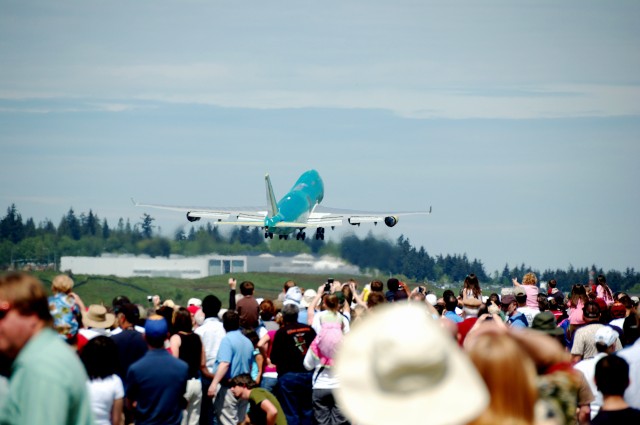
An lift off. Photo by Les Smith.
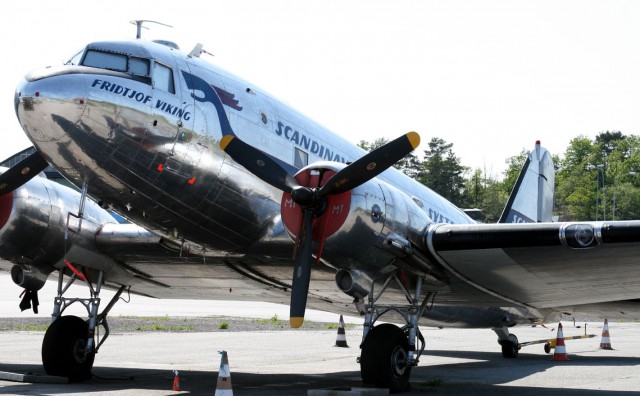
Scandinavian DC-3. Photo by Matt Falcus.
This is a guest post by Matt Falcus. He is an author of the popular Airport Spotting Guides series, and runs the blog AirportSpotting.com which helps aviation enthusiasts make the most out of their hobby with airport, airline and aircraft news and spotting information.
With yet another series of enthusiast’s trips to North Korea recently announced by specialist operator Juche Travel, the demand for flying on historic and rare aircraft types is big business amongst aviation geeks.
I’m sure I don’t need to remind you that classic jets and props are now very much a dying breed, replaced by the modern aircraft produced by Airbus, Boeing and other manufacturers. We can’t deny the fantastic advances in today’s aircraft, but neither can we deny that it’s not quite the same as the old days.
If you’re lucky enough to see first generation Boeing and Douglas aircraft in action today, chances are it’s with a cargo airline. But with a bit of research, it might surprise you to learn that there are still opportunities to fly on older jets, props and Russian types ’“ opportunities which won’t last for long.
It is well documented that there is only one airline still flying the Boeing 707 in passenger services, and many enthusiasts have made the journey to Iran to take a flight. The operator, Saha Air, operates the type on domestic services, however it is upgrading its fleet, meaning and the chances of flying a 707 are rapidly diminishing.
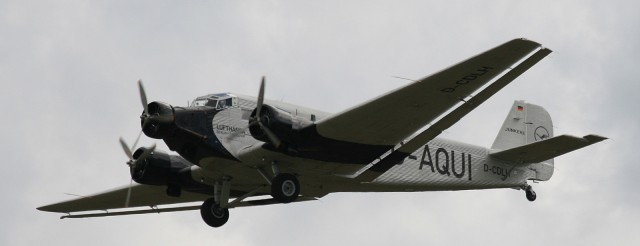
A Lufthansa Junkers J 52 (D-AQUI). Photo by Matt Falcus.
The Boeing 727 can today only be found flying passengers in Africa, Iran and Afghanistan. Perhaps these sound like unlikely destinations, but when you consider that they are flown into Dubai on a daily basis, it makes the chance of flying on a short hop to Tehran and return quite feasible.
Even early Airbus products, which you might consider to be relatively modern ’“ namely the A300B2 and B4 models ’“ are now only operated by Iranian airlines.
Canada is a relatively easy place to find a number of rare types still flying passengers, and much easier to travel to for those in the USA. TV shows such as Ice Pilots NWT have highlighted Buffalo Airways and their DC-3 ’˜sked’ service. But did you know airlines in Canada also fly some of the world’s last commercial Convair 580, DHC-7, and Hawker Siddeley HS.748 services?
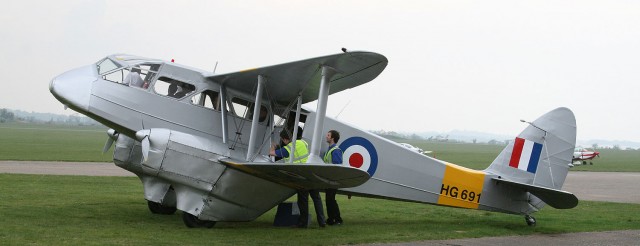
Dragon Rapide by Matt Falcus.
When it comes to Russian airliners, the chance of catching them are running out fast ’“ particularly with the Tupolev TU-134, which has recently been banished from Russia’s airlines. However, organized trips to North Korea are now regularly organized by Juche Travel Services which are targeted at aviation enthusiasts. These offer trips on Air Koryo’s Ilyushin IL-18, IL-62, IL-76, Tupolev TU-134, TU-154, TU-204, and Antonov AN-24. Needless to say you’d be hard pressed to organise flights on each of these types so easily elsewhere.
In Europe you can find some rarities, including the last passenger British Aerospace ATP operator, Next Jet. This airline operates the type on domestic services from Stockholm, Sweden ’“ a pilgrimage I recently made, after missing out on flying the ATP in my native UK.

Classic tri-holder, the MD-11. Photo by Matt Falcus.
One of the most recent types to feature on the endangered list is the McDonnell Douglas MD-11. Anticipated as having massive potential as the natural successor to the DC-10, its debut was as recent as 1990, but today only KLM Royal Dutch Airlines still operates the type in scheduled passenger service. If you haven’t flown the MD-11, you’d better head to Amsterdam soon as the airline has already begun retiring the type and is expected to complete this in 2013.
Finally, when it comes to even older airliners from the early 20th century and wartime periods, there are a number of specialist operators in Europe, Australia, New Zealand, South Africa and the USA still keeping these types alive. For the de Havilland Dove, look up LTU Classik in Dusseldorf. If you want to fly a DC-4, Skyclass of South Africa have an example flying tourists. For the Ford Tri-Motor, look no further than the EAA Museum at Oshkosh, WI. For a Junkers Ju52, there are examples flying in Germany and Switzerland.
For full details on the rarest and most historic airliners still flying passengers, including details of the airlines and countries still flying them, check out my new eBook ’“ Last Chance to Fly.


















